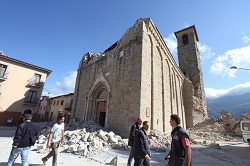EU project successfully deploys robots following Italy earthquake
The project, which is developing solutions for robot-assisted disaster management, quickly assembled a multinational team comprising project members from Germany, Italy and the Czech Republic at short notice and arrived at the earthquake zone on 1 September. This was within 48 hours of receiving the official request for assistance from the Italian Fire Brigade. The team’s mission: to use their UGVs and UAVs to provide 3D textured models of two churches located in Amatrice, the Churches of San Francesco and Sant’ Agostino, national heritage monuments from the Fourteenth Century. Following the earthquake, they were in a state of partial collapse and in need of shoring up to prevent potential further destruction, as well as ensure their preservation and restoration as important national monuments. The models would assist Italian authorities plan the shoring operations and assess the state of various objects of cultural value inside the churches, such as valuable frescos. Mapping the damage The project team deployed two UGVs into the San Francesco Church, teleoperating them entirely out of line of sight, and partially in collaboration with each other – one UGV provided a view of the other one. This allowed for easy manoeuvring in a very constrained space with low connection bandwidth. One of the UGVs operated in the church continuously for four hours. A UAV was also present for a short time in parallel and provided additional views of the UGVs. Several flights were carried out on the outside, and one flight inside of each of the two churches. The project team reported that entering the building with a UAV was a tough challenge, which was manageable thanks to collaboration between three UAVs operated in parallel. While one drone was entering through a hole in the roof, the other two were providing simultaneous video feed from different angles that the pilot was able to use as an additional source of orientation. An assistant was continuously watching the video and giving verbal instructions on how to fly. Mission accomplished Most importantly, the mission fulfilled its goal to collect enough data for the construction of high quality textured 3D models that will be invaluable in assessing and repairing the damaged churches over the coming months. The models have been delivered to the Italian Fire Brigade and the Italian Ministry of Culture. The project team also views their ability to quickly come together and deploy a team to the disaster area at such short notice as an important achievement. Dr. Ivana Kruijff-Korbayová, TRADR project coordinator, has written since the mission to Amatrice that this is the first time to the project’s knowledge that several different kinds of robots have been used in collaboration in a real disaster response deployment. She wrote that the Italian Fire Brigade has since expressed their high appreciation for the success of the TRADR mission in Amatrice and have expressed their intention to continue and further deepen their collaborative efforts with the project. A late breaking report about the TRADR deployment to Amatrice will be presented at the 2016 IEEE International Symposium on Safety, Security and Rescue Robotics (SSRR) from 23 to 27 October 2016 in Lausanne, Switzerland. For more information, please see: project website
Countries
Germany



